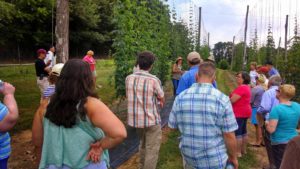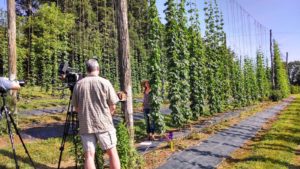The Early Research Hop Yard in Mills River, NC
go.ncsu.edu/readext?466564
en Español / em Português
El inglés es el idioma de control de esta página. En la medida en que haya algún conflicto entre la traducción al inglés y la traducción, el inglés prevalece.
Al hacer clic en el enlace de traducción se activa un servicio de traducción gratuito para convertir la página al español. Al igual que con cualquier traducción por Internet, la conversión no es sensible al contexto y puede que no traduzca el texto en su significado original. NC State Extension no garantiza la exactitud del texto traducido. Por favor, tenga en cuenta que algunas aplicaciones y/o servicios pueden no funcionar como se espera cuando se traducen.
Português
Inglês é o idioma de controle desta página. Na medida que haja algum conflito entre o texto original em Inglês e a tradução, o Inglês prevalece.
Ao clicar no link de tradução, um serviço gratuito de tradução será ativado para converter a página para o Português. Como em qualquer tradução pela internet, a conversão não é sensivel ao contexto e pode não ocorrer a tradução para o significado orginal. O serviço de Extensão da Carolina do Norte (NC State Extension) não garante a exatidão do texto traduzido. Por favor, observe que algumas funções ou serviços podem não funcionar como esperado após a tradução.
English
English is the controlling language of this page. To the extent there is any conflict between the English text and the translation, English controls.
Clicking on the translation link activates a free translation service to convert the page to Spanish. As with any Internet translation, the conversion is not context-sensitive and may not translate the text to its original meaning. NC State Extension does not guarantee the accuracy of the translated text. Please note that some applications and/or services may not function as expected when translated.
Collapse ▲8/24/2022 – This article was originally posted on July 2, 2014. It remains here as a document of the history of the North Carolina hop growing industry. Our hops research continues with a focus on breeding hops for the Southeast.
We have so much going on in our program right now, it is hard to keep everyone informed via our various social media venues. I will try to do short updates on our various programs over the next few weeks. Let’s start with the hops. Our research hop yard is now four years old. It is a variety trial that started out with ten varieties, each replicated four times. We lost one variety, Newport, to downy mildew during the second year. It actually killed the crowns. So last year we planted a few other varieties in those empty sections. We now have four year old Cascade, Chinook, Magnum, Galena, Centennial, Zeus (Columbus), Nugget, Mt. Hood, and Willamette plants and two year old Santiam, Vojvodina, and Canadian Red Vine plants.
We have systemic downy mildew in our yard, but the season started out strong. We thought that just cutting back the plants through late April and removing any downy mildew spikes would keep the disease under control until we started foliar sprays, but once we let the bines grow, it showed up with a vengeance. So we cut our plants back again REALLY late (May 7th), did a soil drench with Ridomil, and then let the plants regrow. There is still a little downy mildew in the yard, but we are managing it (so far) with our weekly spray schedule. After my monthly discussion with a group of hop researchers from the eastern half of North America, we have decided that we will crown the plants next spring (shave off the top of the crowns, just below the soil surface). This is giving good downy mildew and powdery mildew control in Vermont.
The late cut back set the plants back in terms of bine growth, but we have abundant lateral growth and there is a good cone set on our strongest varieties. Many of us were curious about the practice of topping the bines at the summer solstice that Dr. Greg Lewis told us about in spring of 2013, so we gave that a try last week. We have two strings to each crown, so we topped one and left the other to grow. If the bine looked like it had naturally terminated, we left it alone. The theory is that this will encourage more lateral formation and thus more cones. We will keep you informed!
Reviewed by Jeanine Davis, NC Alternative Crops & Organics Program, Department of Horticultural Science, NC State University.




